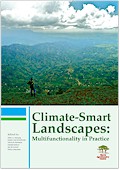| Book Chapter |
 |
|
| Title | The opportunity costs of emission reduction: a methodology and application to support land use planning for low emission development | | Author | S. Suyanto, Andree Ekadinata, Rachmat Mulia, Feri Johana and Atiek Widayati | | Editors | Peter A Minang, Meine van Noordwijk, Olivia E. Freeman, Cheikh Mbow, Jan de Leeuw and Delia Catacutan | | Year | 2015 | | Book Title | Climate-Smart Landscapes: Multifunctionality In Practice | | Publisher | World Agroforestry Centre (ICRAF) | | City of Publication | Nairobi, Kenya | | Number of Pages of the book | 16 | | Pages | 227-241 | | Call Number | BC0413-14 |
|
| Abstract: |
| Compensating landowners and countries for foregone benefits from development is at
the heart of currently discussed mechanisms for Reducing Emissions from Deforestation
and forest Degradation, preserving carbon stock, enhancing forest carbon stock and
sustaining the management of forests (REDD+). For REDD+ efforts to achieve free,
prior and informed consent, the level of compensation should be commensurate with
the magnitude of negative economic consequences of not deforesting, not degrading, or
actively protecting and enhancing carbon stocks. All land use choices have consequences
for the expected future stream of costs and benefits to different stakeholders, which
economists summarize in the concept of Net Present Value (NPV; see below). A choice
for anything other than the most profitable land use implies an ‘opportunity cost’. As it
may also lead to a reduction of net emissions, we can express the ratio of difference in
profitability and the gains in carbon as the minimum carbon price that would allow land
users to break even when engaging in alternative emission reduction land use practices |
|
|
Download file(s): Click icon to download/open file.
|
| |
File Size |
Description |

|
2,065 KB |
Softcopy |
|
|
|
| Viewed in 740 times. Downloaded in 449 times. |